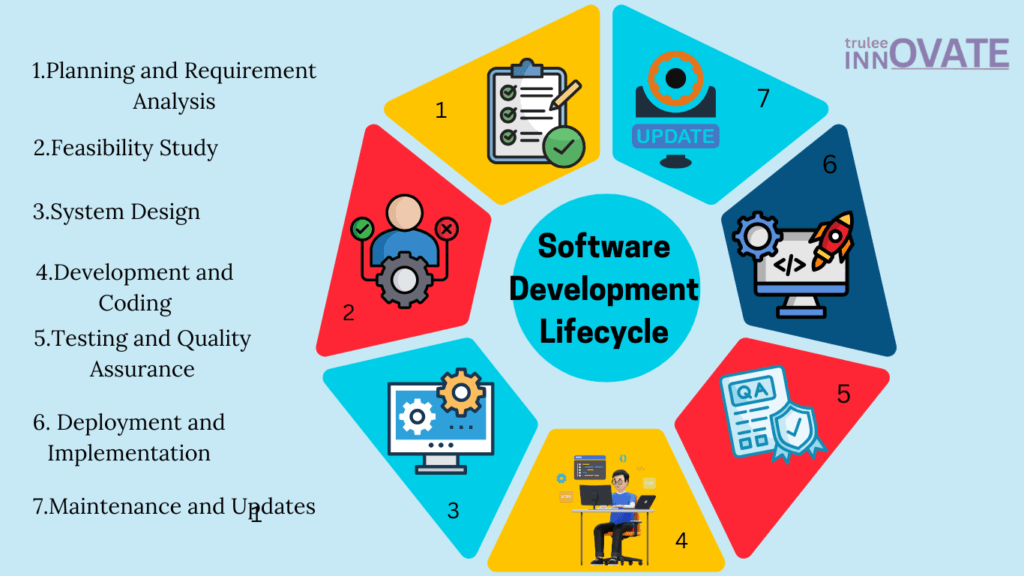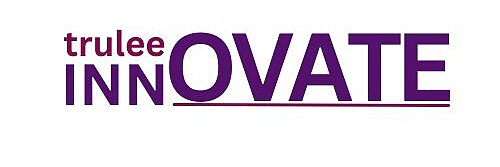Introduction to the Software Development Lifecycle (SDLC)
The Software Development Lifecycle (SDLC) is a structured framework that guides software development teams through the creation and maintenance of software applications. It breaks down the development process into well-defined stages, ensuring the software is delivered on time, within budget, and with high quality.
The SDLC is crucial for:
- Establishing clear goals and objectives.
- Reducing risks and enhancing project efficiency.
- Ensuring that the software aligns with business requirements and user needs.
Key Stages of the Software Development Lifecycle

1. Planning and Requirement Analysis
This stage is the foundation of the Software Development Lifecycle. It involves defining the project’s goals and determining the scope of work. Here’s a detailed look at the steps involved:
Steps in Planning and Requirement Analysis
- Identifying Objectives:
Stakeholders collaborate to identify the business needs the software will address. Objectives are aligned with the company’s goals and customer requirements. - Gathering Requirements:
Requirements are gathered through interviews, surveys, brainstorming sessions, and existing system reviews. - Analyzing Feasibility:
The feasibility of the project is analyzed in terms of budget, timeline, and technical resources. A feasibility report helps determine whether the project is viable. - Documenting Requirements:
Requirements are documented in a Software Requirement Specification (SRS) document, which serves as a guide for the entire project.
Key Outputs:
- SRS document.
- A high-level project plan, including timelines and resource allocation.
2.Feasibility Study
The feasibility study determines whether the project can be successfully executed. This stage minimizes risks and ensures the project aligns with business objectives.
Types of Feasibility Analysis:
- Technical Feasibility:
Evaluates whether the technology required to develop the software is available and accessible. This includes analyzing programming languages, tools, and platforms. - Economic Feasibility:
Ensures that the project is cost-effective. The cost of development is compared against the expected benefits, such as increased efficiency or revenue. - Operational Feasibility:
Analyzes whether the software will operate effectively in the existing business environment. This involves assessing end-user compatibility. - Legal Feasibility:
Checks if the project complies with regulations, data privacy laws, and industry standards.
Key Outputs:
- Feasibility report with a “go” or “no-go” decision.
- Risk assessment and mitigation strategies.
3.System Design
The system design phase translates the requirements into a technical blueprint. This stage is crucial for avoiding miscommunication and ensuring the software’s architecture is robust.
Activities in System Design:
- Architectural Design:
High-level design outlines the system’s structure, including its major components and their relationships. - Detailed Design:
Focuses on designing individual modules, algorithms, and data flows. User interface (UI) and database designs are also developed. - Prototyping:
A prototype may be created to validate the design with stakeholders and gather feedback. - Documentation:
Detailed design documents are prepared for the development team.
Key Outputs:
- Design documents, including UI/UX designs and database schemas.
- A prototype, if applicable.
4. Development and Coding
This is the execution phase, where developers start coding based on the design specifications.
Activities in Development and Coding:
- Setting Up the Environment:
Development environments (IDEs), version control systems, and necessary tools are set up. - Programming:
Code is written according to the design document. Development teams follow coding standards to ensure consistency and maintainability. - Version Control:
Tools like Git are used to manage code versions and track changes. This ensures smooth collaboration among developers. - Peer Reviews:
Code is reviewed by team members to identify and fix errors early in the process.
Key Outputs:
- A functional version of the software.
- Versioned and documented source code.
5. Testing and Quality Assurance
Testing guarantees the software’s dependability, security, and promised functionality. It entails finding and resolving issues prior to deployment
Types of Testing:
- Unit Testing:
Tests individual components or modules of the software to ensure they function correctly. - Integration Testing:
Verifies that different modules work together as intended. - System Testing:
Tests the complete system to ensure it meets the requirements. - User Acceptance Testing (UAT):
End-users test the software to validate that it fulfills their needs. - Performance Testing:
Evaluates how the software performs under various conditions, such as high traffic or low resources.
Key Outputs:
- Bug reports and logs.
- A fully tested version of the software, ready for deployment.
6. Deployment and Implementation
Deployment is the process of delivering the software to the end-users. This stage ensures that the software is installed, configured, and functioning correctly in the production environment.
Steps in Deployment and Implementation:
- Installation:
Software is installed on servers or client machines, depending on the deployment model. - Data Migration:
Existing data is transferred to the new system, ensuring accuracy and completeness. - Configuration:
System settings are adjusted to meet organizational needs. - Training and Support:
Users are trained on how to use the software, and documentation is provided for reference.
Deployment Strategies:
- Big Bang Deployment: The software is launched all at once.
- Phased Deployment: The software is introduced in stages or modules.
- Parallel Deployment: The new system runs alongside the old system until fully functional.
Key Outputs:
- A live, functional software system.
- User manuals and support documentation.
7. Maintenance and Updates
Updating, fixing bugs, and adding new features based on user feedback are all part of maintenance, which keeps software current, secure, and functional.
Types of Maintenance:
1. Corrective Maintenance:
Fixes issues discovered after deployment.
2. Adaptive Maintenance:
which adapts the software to changing environments, like new operating systems.
3. Perfective Maintenance:
Enhances the software by adding new features or improving performance.
4. Preventive Maintenance:
Anticipates potential issues and implements fixes before they occur.
Key Outputs:
- Regular software updates.
- Enhanced system performance and user satisfaction.
Benefits of Following a Structured SDLC
A well-defined Software Development Lifecycle offers several advantages:
- Enhanced productivity: Clear guidelines streamline workflows.
- Risk mitigation: Potential issues are identified early.
- Quality improvement: Structured testing ensures higher reliability.
- Customer satisfaction: Delivering software that meets user needs builds trust and loyalty.
Challenges in the Software Development Lifecycle
Despite its benefits, SDLC has its challenges:
- Miscommunication during requirement analysis.
- Delays due to scope creep or unexpected issues.
- Balancing time, cost, and quality constraints.
To overcome these challenges:
- Invest in proper documentation.
- Foster collaboration between teams.
- Use project management tools to track progress.
Best Practices for Optimizing the SDLC
- Adopt Agile Methodologies: Agile approaches like Scrum and Kanban enable iterative development and adaptability.
- Leverage Automation: Automate testing and deployment to save time and reduce errors.
- Enhance Collaboration: Use tools like Jira and Slack for seamless communication.
- Prioritize Documentation: Maintain updated and comprehensive project documentation.
Different SDLC Models Explained
- Waterfall Model: A linear approach best suited for smaller projects with fixed requirements.
- Agile Model: A flexible approach emphasizing collaboration and iterative progress.
- Iterative Model: Builds the software incrementally, ideal for projects with evolving needs.
- V-Model: A verification and validation-focused model ensuring high quality.
- Spiral Model: Combines iterative development with risk management, suitable for large, complex projects.
The Role of SDLC in Modern Software Development
In today’s fast-paced tech environment, SDLC ensures:
- Scalable and robust software development.
- Alignment with advanced technologies like AI, cloud computing, and DevOps.
- Reduced time-to-market through streamlined processes.
Case Studies: Real-World Applications of SDLC
- E-commerce Platform Development: An online retailer successfully implemented the Agile model to adapt to changing market demands.
- Healthcare System Software: A hospital leveraged the Spiral model to build a secure and compliant patient management system.
Conclusion: The Importance of Mastering the SDLC
. By understanding its stages and implementing best practices, businesses can deliver high-quality software that meets user needs and drives growth.


